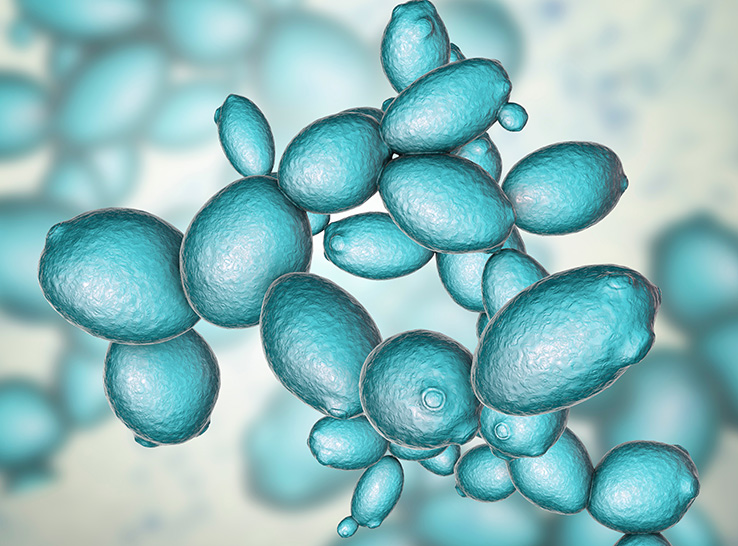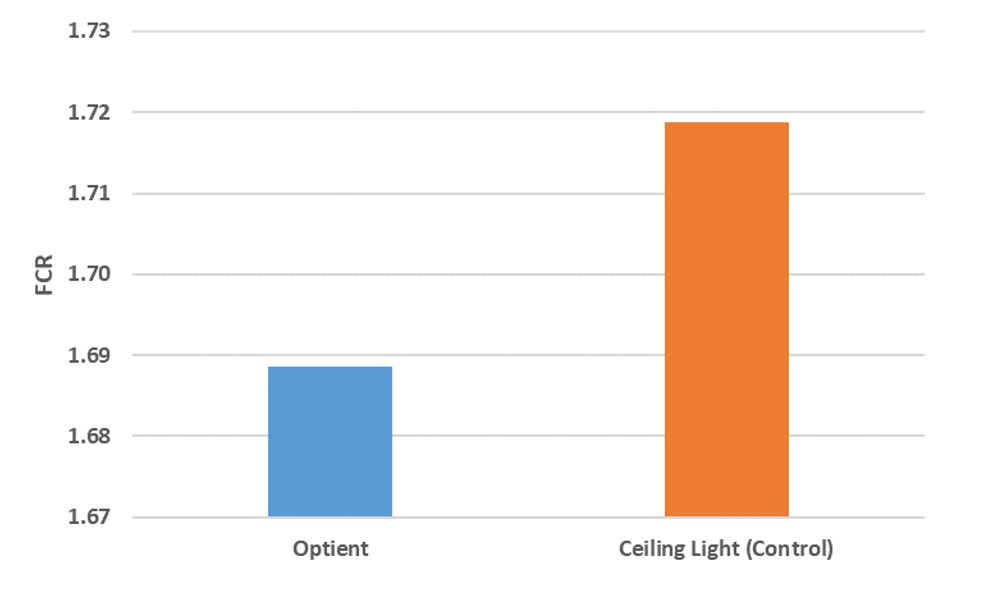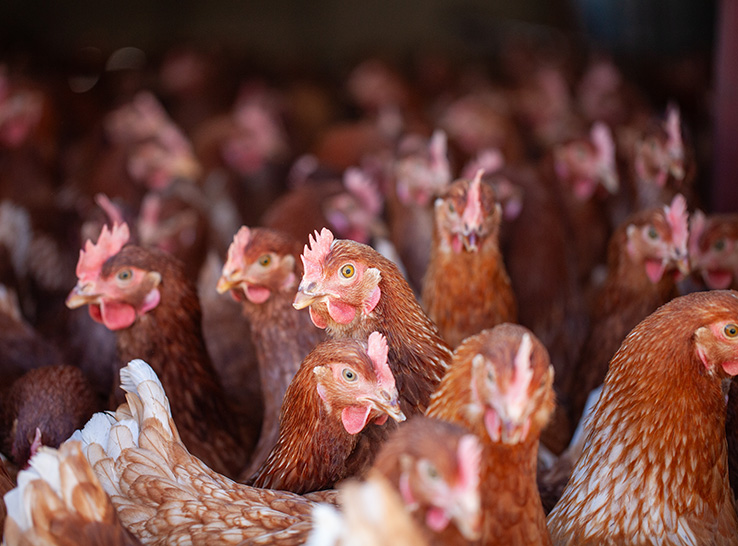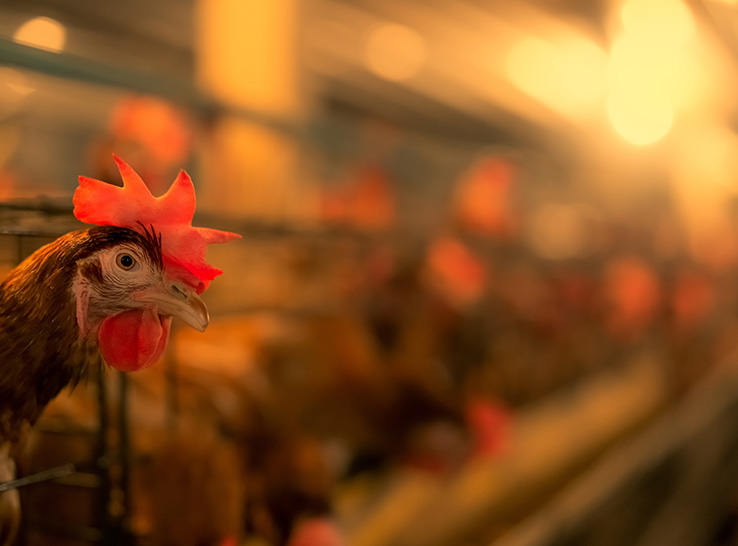By Gabrielle House, PhD
Animal lighting application specialist
ONCE by Signify
Poultry-production systems are continually evolving, with advancements in research and technology allowing greater precision in meeting the unique needs of bird genetic lines and individual flocks. Lighting, along with feeding, ventilation and other key systems, play a critical role in the growth and behavior of poultry.
Poultry have heightened photosensitivity and complex visual systems that enable them to perceive light differently from humans. Moreover, various poultry species and genetic lines will react to light in diverse ways depending on the light’s color, intensity, distribution and duration.
It is therefore imperative to take a comprehensive approach to lighting options to determine which is the most suitable choice for your flock. However, whether enhancing your existing poultry house with upgrades or embarking on a new build, selecting the appropriate equipment to incorporate into your house can be a daunting task. When you come to the “lighting” stage of your to-do list, the vast array of lighting-system types, colors, brands and styles can be overwhelming.
To make the selection feel a bit less daunting, here are the four main factors to consider when selecting which light system is best for your poultry house: light source, light spectrum, dimmability and light plan design.
1. Light source
The poultry industry has several light sources to choose from for use in houses, including incandescent, compact fluorescent (CFL) and light-emitting diode (LED) lamps. Of all the available options, LEDs have become the preferred artificial light source due to their potential spectral flexibility (ability to adjust light wavelength or color output), reduced heat production and high energy efficiency compared to incandescent and CFL light sources.
Unlike incandescent lamps and CFLs, which use heat or charged gas to produce light, LEDs use LED epitaxy technology, in which electrons migrate between two gallium-based semiconducting materials to produce light. This technology minimizes the amount of heat generated from the lamp and provides spectral flexibility through different combinations of semiconducting materials and phosphor coatings.
Poultry-specific LEDs are engineered to be highly energy efficient (100+ lumens/watt) and durable enough to withstand barn environments.
It is essential to ensure that all lights in poultry houses are rated IP-65 or higher, meaning they are entirely sealed against dust and protected against low-pressure water jets from any direction.
With the increasing demand for sustainable technology in the poultry industry, the advancements in LED design over the past 10 years have paved the way for an efficient and safe lighting solution for poultry houses.
2. Light spectrum
Because poultry are highly photosensitive, the spectrum of an artificial light source can influence bird performance, behavior and well-being throughout its life.
However, not every bird species, genetic line or age responds to light colors in the same way. Thus, growers should consider the nuances in bird preference and performance under various portions of the light spectrum when deciding which lighting to install in their houses.
Blue and green light
Previous research has reported many positive impacts of blue and green light on broiler and pullet performance and welfare. For example, green light has been shown to accelerate broiler muscle growth and stimulated overall growth during the first half of grow-out, while blue light stimulated growth in older boilers during the second half of grow-out.1
Also, compared to white light, blue light has been associated with improved immune response,2 reduced physiological indicators of stress and a lower fear response in broilers.3 In addition, layer pullets have demonstrated preferences for spending time under blue light compared to other light colors.4
ONCE by Signify solution
The ONCE by Signify NatureDynamics DOME lighting system for broilers — a multi-channel, fully customizable solution with wireless control — can be used as a tool to deliver dynamic light recipes to broilers from placement to harvest.
Through years of research and innovation with universities and global field trials, ONCE developed NatureDynamics DOME light recipes to enhance broiler welfare and performance. Results of 48 global field trials demonstrated that NatureDynamics DOME provided an average 3-point (0.03) feed-conversion rate (FCR) improvement compared to standard white-light sources (Figure 1).
The NatureDynamics DOME system has also undergone six rigorous, academically validated welfare measurements, demonstrating an ability to reduce fear and stress responses of broilers.
Photostimulation
Mature laying hens and breeders require visual and non-visual photostimulation to activate the reproductive axis and become fertile.
Visual photoreception facilitates sight, allowing the bird to respond to conspecifics and the surrounding environment. Nonvisual photoreception doesn’t contribute to sight but it stimulates many biological processes in the body, such as the reproductive axis, metabolism, circadian rhythm and immune system.5
For photoreceptors in the brain to be activated, light must penetrate through the layers of tissue and bone to reach the brain. Light wavelengths in the red portion of the light spectrum can most effectively reach the photosensitive areas of the brain.
Compared to short-wavelength light, long wavelengths, such as those perceived as red light, interact less with travel mediums such as air, feathers, skin or bone and will travel further through these mediums.
Previous research concluded that, at the normal light intensities that breeders and layers are reared, red light is required to stimulate the reproductive axis.6
Other research reported that including supplemental red light in the artificial-light spectrum resulted in early laying performance,7,8 as well as reduced physiological indicators of stress.9,10
Figure 1. FCR results from 48 ONCE NatureDynamics DOME broiler global field trials
3. Dimmability
As with all other production systems used in modern poultry houses, it is crucial to maintain precise control over light intensity from 100% to 0.1% to mitigate bird stress and behavioral issues during daily light transitions.
Commercially grown poultry typically require bright light during brooding but prefer areas with dimmer light intensity to rest as they grow older.
For broilers and pullets, it is essential to ensure barn controllers and lights have the capability to gradually reduce the light intensity over multiple days when transitioning from the brood intensity to the grow-out intensity. Doing so will allow young birds to adjust to the light settings over time without causing additional stress during a very critical period of growth for both genetic lines.
As with gradual transitions between brood and grow-out intensities, introducing birds to changes in the light intensity during daily lights on/off transitions is critical for mitigating bird stress.
Additionally, ensuring LEDs used in birds’ areas have low-end dimmability is extremely important for ensuring a smooth transition during daily dawn/dusk periods. Sudden jumps in light intensity during ramp-up or ramp-down periods can cause excess flock stress, particularly during dawn or dusk periods.
Therefore, growers must be aware of the importance of using poultry-specific LEDs that have a wider dimmability range, ideally between 100% to 0.1%. Although LEDs with this dimming range may be more expensive, other less expensive LEDs are less likely to come with this wide dimming capability and may have other poor response characteristics to low-end dimming.
Poultry-specific LEDs with wide dimming capabilities will result in more gradual light-transition periods, ultimately reducing bird stress. This is especially important for laying hens in complex environments, such as cage-free aviary systems, where proper dimming sequences are essential to encourage birds to migrate up into the aviary system at night to perch and prevent the formation of habits such as floor egg laying.
Notably, sudden lighting changes without a dimming sequence can startle hens in cage-free systems and result in injuries or mortalities related to crash landings, piling or stress.
By utilizing poultry-specific LEDs with flexible dimmability, growers can ensure the safety and well-being of their flock while maintaining optimal production levels.
4. Plan design
Proper lighting distribution and intensity are crucial factors in achieving poultry performance goals. Whether retrofitting an existing structure or installing lighting in a new one, it is imperative to understand how light characteristics can impact the overall lighting environment across the floor of the house.
The placement of lighting lines and spacing can significantly affect light distribution. Importantly, the location of key systems in the house could potentially impact light-line placement in the house, such as feeder/drinker lines, heaters, nests and slats.
Light lines can be strategically installed around these different systems to facilitate intentional bird movement and behavior in different zones of the house.
For instance, bright light intensity and uniform light distribution in the scratch area of a broiler breeder house can encourage mating activity and discourage floor egg laying in this specific area of the house. In this same house, the slat area just outside of the nest should be approximately 40% dimmer than the scratch area to cater to the natural preferences of breeder hens to lay in dimly illuminated nesting areas.
Gradient lighting
Gradient-lighting sources are a new lighting innovation that enables birds to choose between various intensities based on their innate preferences for performing specific behaviors under specific light conditions.
Research indicates that broilers prefer lower light intensities to rest once they are post-brooding but also prefer to feed under high-intensity lighting, regardless of age. Academic publications, such as Kang, et al., 2023,11 and field studies with the ONCE Optient gradient-lighting system have reported that providing pre-defined areas of bright light on feedlines with gradually reducing intensity out to areas away from feedlines for resting enhanced broiler welfare and production.
Research by Kang, et al, concluded that birds reared under gradient lighting had reduced litter moisture, reduced footpad lesions, reduced leg-problem culled birds at day 49, increased activity and dustbathing behaviors and reduced fear and stress responses compared to birds reared under ceiling lighting.12
Gradient-lighting birds in this study also had an improved FCR by 1 to 3 points. Optient commercial field trials reflect these FCR improvements, with an average 3-point improvement in FCR using Optient compared to standard white ceiling-lighting solutions (Figure 2).
Some animal lighting companies, including ONCE, offer CAD (computer-aided design)-based light plans that provide to-scale renderings of houses with specific light products. These renderings can measure the light intensity at bird-eye height for all surfaces accessible to the birds in the house. Surface reflectivity, color and light orientation can all be adjusted to create a representative and customized light plan for any poultry house.
Figure 2. FCR results from 13 ONCE Optient broiler field trials
Conclusion
Lighting is a critical component of poultry-house design and should be given careful consideration. With the increasing demand for sustainable technology in the poultry industry, LEDs have become the preferred artificial light source due to their spectral flexibility, reduced heat production and high energy efficiency.
When selecting the most suitable lighting option for poultry, growers should consider factors such as the type of light source, light spectrum, light intensity and light distribution. By taking a comprehensive approach, growers can select the optimal lighting solution for their flock, which can lead to improved bird performance, behavior and well-being throughout their life cycle.
Citations
1 Rozenboim I, Biran I, Chaiseha Y, Yahav S, Rosenstrauch A, Sklan D, Halevy O. The effect of a green and blue monochromatic light combination on broiler growth and development. Poult Sci. 2004;83(5):842-845.
2 Sultana S, Hassan MR, Choe HS, Ryu KS. The effect of monochromatic and mixed LED light colour on the behaviour and fear responses of broiler chicken. Avian Biol Res. 2013;6(3):207-214.
3 Mohamed RA, Eltholth MM, El-Saidy NR. Rearing broiler chickens under monochromatic blue light improve performance and reduce fear and stress during pre-slaughter handling and transportation. Biotechnol Anim Husband. 2014;30(3):457-471.
4 Li G, Li B, Zhao Y, Shi Z, Liu Y, Zheng W. Layer pullet preferences for light colors of light-emitting diodes. Anim., 2019;13(6):1245-1251.
5 Cassone VM. Avian circadian organization. In: Mechanisms of circadian systems in animals and their clinical relevance. 2014:69-96. Cham: Springer International Publishing.
6 Baxter M, Joseph N, Osborne VR, Bédécarrats GY. Red light is necessary to activate the reproductive axis in chickens independently of the retina of the eye. Poult Sci. 2014;93(5):1289-1297.
7 Huber-Eicher B, Suter A, Spring-Stähli P. Effects of colored light-emitting diode illumination on behavior and performance of laying hens. Poult Sci. 2013;92(4):869-873.
8 Gongruttananun N, Guntapa P. Effects of Red Light Illumination on Productivity, Fertility, Hatchability and Energy Efficiency of Thai Indigenous Hens. Agricul Nat Res. 2012;46:51-63.
9 Archer GS. How does red light affect layer production, fear, and stress? Poult Sci. 2019;98:3-8.
10 House GM. The Benefits of Red Light for Layer and Breeder Hens. ONCE Inc. 2023. https://www.once.lighting/en/news/the-benefits-of-red-light-for-layer-and-breeder-hens.
11 Kang SW, Christensen KD, Kidd Jr MT, Orlowski SK, Clark J. Effects of a variable light intensity lighting program on the welfare and performance of commercial broiler chickens. Front Physiol. 2023;14:1059055.
12 Ibid.








